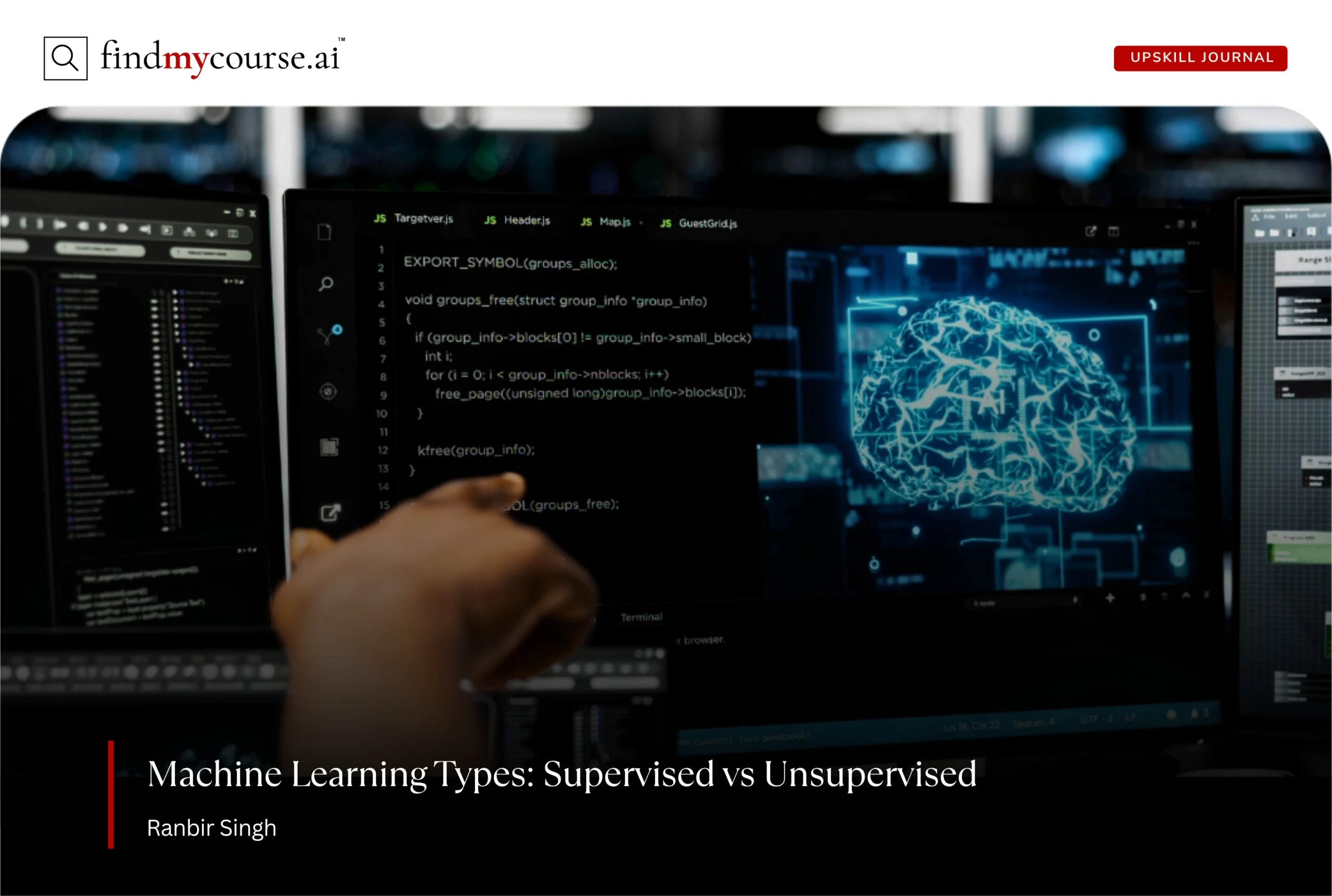In today’s digital age, machines do more than just follow commands—they actually learn. Ever wonder how Netflix knows what movies you’ll love, or how your email sorts out spam? This amazing technology is called machine learning, powering much of the technology we use every day, from recommending your next favourite song to filtering spam emails. At the heart of this innovation lie two essential methods: supervised and unsupervised machine learning. So, if you’re studying about how AI works or thinking about a tech career, this guide will walk you through these two key types in a clear and easy-to-understand way.
How Machine Learning Methods Influence Everyday Life
Both supervised and unsupervised machine learning are super important for building the smart systems we rely on every day. They’re shaping how we live, work, and interact with technology, from social media to medical tools.
- Supervised learning is powerful when we have a lot of data with clear labels. Think of it like teaching a student with an answer key. It’s great for predicting stock prices, diagnosing diseases, or helping a self-driving car recognize road signs.
- Unsupervised learning is valuable when we’re exploring new territory. It’s ideal for analyzing data where we don’t know what patterns to expect. Imagine giving a detective a bunch of clues without telling them about crime – they have to find connections! It’s useful for understanding market trends or organizing thousands of documents.
In addition, knowing when to use each method helps businesses make smarter decisions and create better products.
What is Supervised Machine Learning?
Supervised machine learning is a way for computers to learn using examples that already include the right answers. It’s like giving a student a worksheet that has both the questions and the correct answers. By studying those examples, the student learns how to solve similar problems on their own later.
In machine learning terms, we give the computer a dataset where each piece of information has an input (like a picture of an animal) and the correct output (like the label “cat” or “dog”). The computer uses these examples to learn how the input and output are connected. Later, when it sees new data it hasn’t seen before, it can make predictions based on what it has learned.
Because it has the “right answers,” the computer can see if it was correct. If it’s wrong, it adjusts, getting better with each try – like a student who learns from their mistakes.
Real-Life Examples of Supervised Learning
You use supervised learning every day!
- Email spam filters learn to recognize spam by studying emails humans have already labeled as “spam” or “not spam.”
- Voice assistants (like Siri or Alexa) are trained using thousands of voice recordings that have been labeled with their correct text.
- Medical diagnosis systems analyze patient data labeled with known conditions to help predict future diagnoses.
Tasks in Supervised Learning
Supervised learning can do two main types of jobs:
- Classification: This means sorting data into categories. For example, deciding if an email is “spam” or “not spam,” or if a customer will “churn” (leave) or “not churn.”
- Regression: This means predicting a continuous value (a number). For example, predicting a house price, tomorrow’s temperature, or a person’s age.
What is Unsupervised Machine Learning?
Unsupervised machine learning is a bit different. It’s what happens when a computer is given data without any answers—it must explore the data and figure things out on its own. Imagine giving someone a big pile of puzzle pieces and asking them to group similar ones together, without telling them what the final picture should be.
Instead of learning from examples with labels, the computer studies the structure of the data. It tries to find patterns, similarities, or hidden relationships. This helps uncover insights that humans might miss because there’s just too much data to look at!
Real-Life Examples of Unsupervised Learning
You’ve likely seen unsupervised learning at work even if you didn’t realize it:
- Retailers use it to group customers based on their shopping habits to design personalized offers (e.g., finding groups of “frequent organic buyers”).
- Streaming platforms analyze your viewing habits to create content clusters and recommend shows you might like, even if no human specifically tagged them that way.
- Banks use it to detect unusual transactions that might indicate fraud, by finding patterns that don’t fit the norm.
Tasks in Unsupervised Learning
Unsupervised learning is commonly used for:
- Clustering: This means grouping similar data points together. Like finding different types of customers (e.g., “bargain hunters” vs. “luxury shoppers”) or organizing products by preference.
- Association: This means discovering patterns or rules. A classic example is “people who buy diapers also tend to buy baby wipes.” This helps stores arrange items or make recommendations.
Supervised and Unsupervised Machine Learning: Key Differences
Understanding the differences between supervised and unsupervised machine learning is key to seeing how machines learn, adapt, and make decisions. While both approaches aim to find insights in data, they do so in very different ways—each suited for specific kinds of problems.
A Side-by-Side Overview
| Feature | Supervised Learning | Unsupervised Learning |
| Data Type | Uses labeled data with known outcomes | Uses unlabeled data without predefined answers |
| Objective | Learns from examples to make predictions | Discovers hidden patterns, groupings, or relationships |
| Typical Tasks | Classification (e.g., spam detection), Regression (e.g., price prediction) | Clustering (e.g., customer segmentation), Association (e.g., product recommendations) |
| Real-World Use | Medical diagnoses, voice recognition, fraud detection | Market analysis, trend discovery, anomaly detection |
| Learning Approach | Guided by human-labeled data | Learns independently through data exploration |
Supervised learning is structured and goal-oriented. It’s most effective when you already know the outcome you want and have historical data to support it. On the other hand, unsupervised learning thrives in open-ended scenarios, where the goal is to let the data speak for itself—revealing trends and patterns that may not be immediately obvious.
In simple terms, supervised learning teaches machines by example, while unsupervised learning allows them to figure things out on their own.
Limitations of Supervised and Unsupervised Learning
While these two learning methods are essential to machine learning, they also come with specific challenges that are important to understand.
Supervised Learning Limitations
- Requires Labeled Data: Building a high-quality dataset with correct labels can be time-consuming and expensive.
- Bias in Training Data: If the training examples contain bias, the model may learn and reinforce those same biases.
- Overfitting Risk: The model might perform well on training data but poorly on new, unseen data if not properly managed.
Unsupervised Learning Limitations
- Hard to Evaluate: With no “correct” answers, it’s difficult to measure accuracy or validate the model’s results.
- Interpretation Challenges: The discovered patterns or clusters may not always have a clear or useful meaning without expert analysis.
- Parameter Sensitivity: Some algorithms require pre-setting values (like number of clusters), which can influence the outcome significantly.
By recognizing these limitations, we can choose the right method for the task, avoid common pitfalls, and apply machine learning more effectively in real-world situations.
How to Learn More and Explore Further
If you’re intrigued by how machines learn, now is a great time to explore further. You can study online through beginner-friendly platforms like Coursera, or Google’s Machine Learning Crash Course. These resources use visuals and real-life examples to make concepts simple and engaging.
As you dive deeper, you’ll encounter popular algorithms. For example:
- Decision Trees: Think of them like a “choose your own adventure” flow chart that helps predict things, like whether someone will buy a product.
- K-Means Clustering: Helps group similar things together, like finding different types of customers in a store.
- Linear Regression: Predicts numbers based on trends, like estimating house prices based on size.
- Association Rules: Find common connections, like “people who buy coffee often buy sugar too”—useful for recommending products!
With tools like Google Colab or Kaggle, you can even practice building models using real data. These are like free online playgrounds where you can try out machine learning without installing anything complicated on your computer. Learning about supervised and unsupervised machine learning isn’t just fascinating—it’s also a valuable skill for the future!
Conclusion
To wrap up, supervised and unsupervised machine learning represent two essential ways machines learn from data—either by following known examples or by discovering hidden patterns on their own. Together, they form the backbone of intelligent systems that learn, adapt, and improve. Whether you’re a beginner, a business owner, or a future data scientist, understanding these approaches is a simple yet powerful step toward unlocking the full potential of AI in everyday life. And whenever you’re ready to go further, our AI assistant is here to make the journey effortless.



One thought on “A Simple Guide to Supervised and Unsupervised Machine Learning”
Comments are closed.